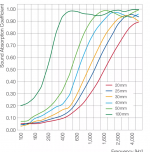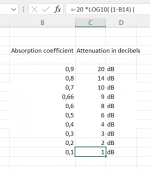Are you expecting to leave the standing waves untreated?don't use same dimensions for loudspeaker enclosure walls like 400x400
Small expansion to this: damping materials don't have equal attenuation on all frequencies. While most materials are very effective around 1kHz even as thin layer there can be significant differences lower in frequency and big enough boxes this needs to be taken account.So the bigger the box the bigger the damping material simply means your damping should be a fraction of the box dimensions. Therefore it's not like there is an actual problem.
While the increasing thickness of material, for bigger box, increases attenuation on lower frequencies some materials might still not have enough attenuation. Basotect absorption coefficients attached to illustrate some coefficients, grabbed from here https://plastics-rubber.basf.com/global/en/performance_polymers/products/basotect.html
ps. while the absorption depends on many things including air space between the material and wall, the absorption coefficients give a hint how the material performs at low frequencies.
Carry on 🙂
Attachments
Of course not. But why not try to fight the effects of standing waves from the ground up? The easiest way to do this is to choose the proportions of the walls of the box well.Are you expecting to leave the standing waves untreated?
^Yeah, all this is mainly problem of two (or one) way speaker where single woofer plays both bass and mid... either the bass or mids (SPL limit) are more or less compromised no matter what. Someone wanting to make two way box hopefully knows this and is fine with it, otherwise 3-way system is the way to go. Two way with sub for example, which can keep the two way box relatively small. Small box will make one to have compromise between low extension and SPL. Low extension is not problem if there is another way to handle that, which makes the compromises between size SPL and extension go away (separates issue from mid frequencies).
YSDR, you can spread them and that's not a bad thing. However they are still the product of reflections.
tmuikku, you would choose a three way over a two way because of what happens inside the box?
tmuikku, you would choose a three way over a two way because of what happens inside the box?
Not just inside but outside dimensions as well, and considering drivers electro-mechanical reality they live in, it just makes sense. On a two way both drivers work on their extremes and thus are at least SPL limited. If SPL and bandwidth requirement is not too much then why not two or less way, but as you know it is not that simple, depends on application 🙂
Of course, that's why I said "no" to your previous question. So, spreading plus damping is usually more effective than just spreading or just damping.YSDR, you can spread them and that's not a bad thing. However they are still the product of reflections.
A three-way is also an option if I fancy it down the line. If I remove the standing wave remedy I get a bit nicer of an extension and can cross to a mid at 200hz without a hint of disruption. I was also thinking about a co-ax top three way at some point which as you say, tmuikku, removes all compromises. Two way first though!
I am using a box that is 400 x 400 x 400 and it sounds great, but i am using a lot of damping, i hate the sound of empty enclosures as empty rooms
A box made with golden ratio or cube root 2 (inside), from not very thin MDF , with proper bracing, sounds good even without damping material. At least that's my experience.
Indeed! If one looks at the pioneer's designs, (minimal density) damping was usually limited to just the area directly behind the driver(s) combined with relatively thin panels with strategically placed bracing to maximize acoustic efficiency; a tuned musical instrument in effect, so for most folks not what we normally want these days, but otherwise more rigid/massive panels to the pioneer's concept is a worthwhile goal.
Never found it made a difference in practice, especially with sufficient bracing and enough and well placed stuffing. I think, based on experience, that GR is mainly mythology.A box made with golden ratio
Were they a Tardis? How else did you fit a 10" driver into a 6" cube?i had 6" cubes, dampening didn't do squat for the 1k peak.
i had 6" cubes, dampening didn't do squat for the 1k peak.
damping an air cavity resonance at 1khz should not be difficult with proper damping material, maybe there was something else, or you must have had a bad luck
Well yeah most damping materials should be effective enough at 1kHz. But as it is all relative, ~1kHz has ~12" wavelength so it is the first mode, at half wavelength inside 6" cube. The box should possibly be almost filled up to have enough attenuation for it because it is only half wavelength. Or perhaps the material should have some air gap behind, so damping right at the magnet and then some empty space behind or something. Anyway, it is half period from the signal (full wl there and back to cone) and directly affects the woofer I speculate, unlike higher modes which would come a bit later (more phase rotation) and as shorter wavelength would have probably much more attenuation interacting with the damping material. Trying to reason on it just now 🙂 Usually this is not a big deal and just matter of adding more damping material, but can be.
I suspect the lowest mode (of any dimension) is always the most problematic, or most difficult to get rid of if problematic, and shows most impact on the response and always happens within the driver pass band (can't have smaller box than the driver can we). Mostly because what ever damping material there is it is more effective on higher frequencies, higher modes, than the lower ones. Exception would be subwoofers / bass boxes where the driver is crossed over much below the driver diameter wavelength, all modes fall far enough outside pass band.
Open baffle and passive cardioid are superior in this regard, not much to bounce around because there is no or almost no box. Perhaps the various "daggers" and other types that taper the volume and prevent the lowest mode come back to the cone, from the back wall, work very nice as well. Or meta material, what ever.
Hornresp shows that woofer (or acoustic center of woofers) mid way a dimension prevents the mode happening so if woofer is center of baffle only the front / back first mode happens. If box is shallow then it might be just outside the pass band. Otherwise it is damping material tuning time, or just leave it be and call it musicality and sell with big buck. 😀
I suspect the lowest mode (of any dimension) is always the most problematic, or most difficult to get rid of if problematic, and shows most impact on the response and always happens within the driver pass band (can't have smaller box than the driver can we). Mostly because what ever damping material there is it is more effective on higher frequencies, higher modes, than the lower ones. Exception would be subwoofers / bass boxes where the driver is crossed over much below the driver diameter wavelength, all modes fall far enough outside pass band.
Open baffle and passive cardioid are superior in this regard, not much to bounce around because there is no or almost no box. Perhaps the various "daggers" and other types that taper the volume and prevent the lowest mode come back to the cone, from the back wall, work very nice as well. Or meta material, what ever.
Hornresp shows that woofer (or acoustic center of woofers) mid way a dimension prevents the mode happening so if woofer is center of baffle only the front / back first mode happens. If box is shallow then it might be just outside the pass band. Otherwise it is damping material tuning time, or just leave it be and call it musicality and sell with big buck. 😀
Last edited:
Sorry, but I thought making it a cube and having the modes at the same frequency was obviously an incorrect move and going to make it much more difficult to damp.
Yeah why not. Some simulation might reveal what is actually happening inside, otherwise it is just simplified thinking on the concept, size of box vs. size of sound and how sound interacts with physical objects. Specialty with the lowest mode is the size of it, it is bigger than the box.
By the way, did you listen to it grahamgraham, the ~400Hz issue in your box?
By the way, did you listen to it grahamgraham, the ~400Hz issue in your box?
Last edited:
The standing wave inside a box can be calculated with f=c/(2×L)
(Without correction)
c= speed of sound (344m/s)
L = length in meters.
1kHz is about 17.2cm which is about 6.77 inches. (So NOT 12 inch !!!)
Most damping materials are doing fine from 500Hz and up.
Some thicker/more dense ones can go a little lower.
A good way to get rid of those standing waves or to make them more manageable is to place an angled board. Which effectively makes it a transmission line.
This can also be done with closed boxes.
A couple of angled shorter ones might also help.
Those standing waves are very easy to measure with a burst decay diagram (= waterfall shown in periods) and match very closely with the calculated values (when end correction is being used)
(Without correction)
c= speed of sound (344m/s)
L = length in meters.
1kHz is about 17.2cm which is about 6.77 inches. (So NOT 12 inch !!!)
Most damping materials are doing fine from 500Hz and up.
Some thicker/more dense ones can go a little lower.
A good way to get rid of those standing waves or to make them more manageable is to place an angled board. Which effectively makes it a transmission line.
This can also be done with closed boxes.
A couple of angled shorter ones might also help.
Those standing waves are very easy to measure with a burst decay diagram (= waterfall shown in periods) and match very closely with the calculated values (when end correction is being used)
- Home
- Loudspeakers
- Multi-Way
- 10" + CD/Horn 2-Way

